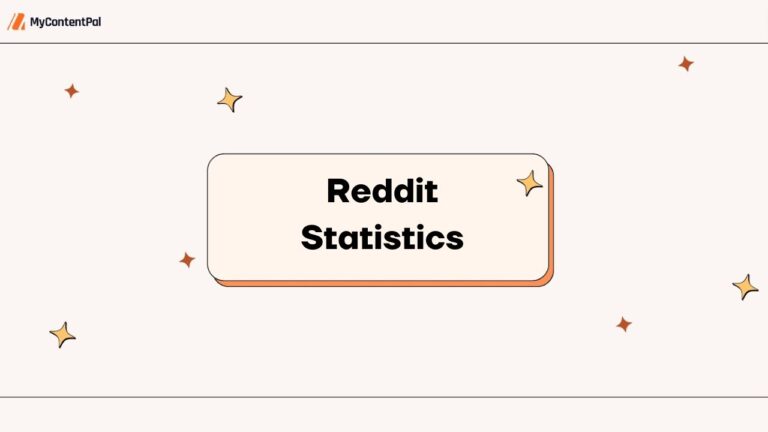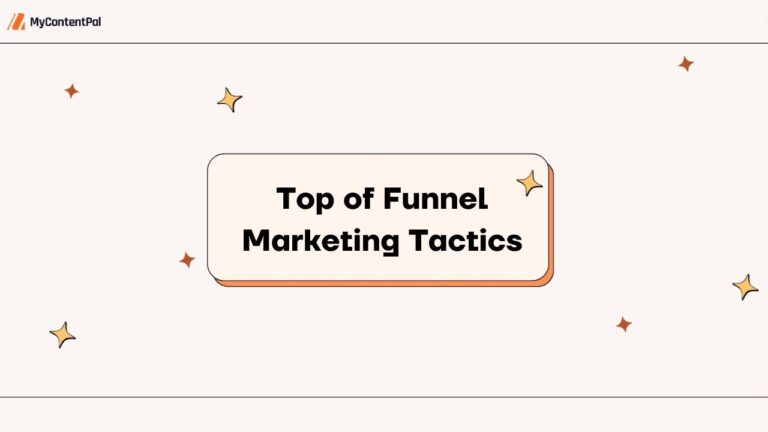In a world where 70% of consumers say they feel closer to a business that provides useful content, connecting with your clients online isn’t just a good idea—it’s critical.
However, most coaches either don’t know how to start creating content or waste hours on random posts that don’t resonate with clients. That’s where the right strategy comes in.
This guide will walk you through the steps to turn your coaching business into a client-attracting powerhouse and establish your authority in your niche.
The results?
- More leads without cold calling.
- Content perfectly matched to your audience’s needs.
- Clients who feel inspired before they even work with you.
- Credibility that positions you as the go-to coach.
- Relationships that last—built on trust and value.
Let’s start with step one—knowing who you’re talking to.
Knowing Your Audience: Your Key to Powerful Content

The content on your website is only effective if it speaks to the right people in the right way.
Imagine publishing expertly crafted content that no one relates to—that’s what happens when you skip this step. You need to know exactly who’s on the other side of the screen. Their desires, struggles, and questions are the foundation of creating valuable content. Without it, it’s a shot in the dark.
Key tips to define and narrow down your target audience
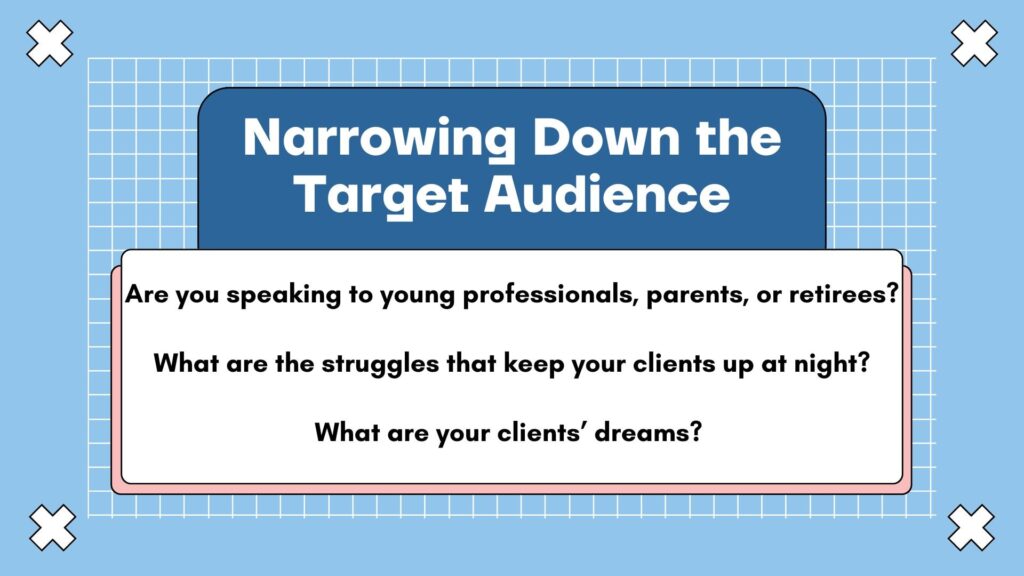
1. Demographics
Think of this as your audience’s “basic profile.” Age, profession, location, and income—these factors reveal where your audience is coming from. For example, are you speaking to young professionals climbing the corporate ladder, or retirees focused on wellness and personal fulfillment?
Use tools like Google Analytics to gather specific demographic data. With these, you can see which age groups and professions are most responsive to your content. This level of detail lets you tailor your messaging—whether it’s targeting financial wellness for mid-career professionals or stress management for entrepreneurs.
2. Psychographics
Demographics tell you who your audience is; psychographics reveal why they care. These insights go beyond the basics to uncover motivators, aspirations, and pain points.
Ask yourself: Are they trying to overcome fears, strengthen relationships, or get unstuck in their careers? Knowing these motivations is crucial to building real connections.
SparkToro is an amazing tool for this. It reveals your audience’s interests, what they read, listen to, and who they follow. For example, if your clients are career-driven professionals, the tool can help you see which podcasts they listen to, allowing you to frame your content in ways that resonate with their mindset.
3. Surveys and polls
Surveys and polls help you uncover what your audience wants to learn about, straight from the source. They’re great tools for identifying content topics that resonate with your clients.
Platforms like SurveyMonkey or Google Forms make it easy to ask questions such as, “What topics do you search for most online?” or “What challenges do you want solutions for?” Use these insights to shape content that addresses their real needs and searches.
Pro Tip: Offer a small incentive, like a resource guide or discount, to encourage clients to fill out your survey. Their answers will give you a goldmine of insights to guide your strategy.
Create three client personas

Think of personas as “models” of your ideal client. Define at least three, for example:
- One person who’s struggling with major life changes.
- One college student navigating change on a tight budget.
- One parent balancing family life while working toward career advancement.
When writing content, imagine talking directly to one of these personas. It makes your message laser-focused.
How To Create A Content Marketing Strategy For Coaches

Want to stand out as a coach? A smart content strategy is your secret weapon. Let’s break down the key steps to create one that drives results.
1. Setting goals that resonate
When it comes to content marketing, winging it won’t cut it. You need a solid content strategy, rooted in purpose. By setting specific goals and choosing the right types of content, you can guide your audience, build authority, and inspire your readers to take action on your pages.
2. Defining your goals
Clear goals are the difference between creating content that truly connects and content that fades into the noise. Start with the big question: What do you want your content to achieve? Here’s a roadmap to help define your goals:
2.1. Brand awareness
If you’re new to the scene, focus on getting noticed and building credibility. Set clear KPIs to measure progress, like:
Increasing website traffic:
- KPIs: Drive 1,000 new visitors to your website within the next 3 months.
- How: Achieve this by implementing targeted content marketing campaigns, optimizing blog posts for SEO, and promoting your content through email marketing and social media channels.
Expanding social media presence:
- KPIs: Gain 200 new, engaged social media followers on platforms like Instagram, LinkedIn, or Twitter over the next 3 months.
- How: Achieve this by creating and consistently posting high-value, audience-specific content, running a small-budget paid campaign, and actively engaging with your audience through comments and direct messages.
Boosting engagement rates:
- KPIs: Increase engagement rates to at least 5% across social media platforms (likes, comments, shares, and saves). Aim for 20 meaningful comments per post or 50 total engagements on average within the next 3 months.
- How: Encourage interaction by running polls, asking questions, and posting interactive or controversial topics that prompt thoughtful discussion. For example, “What’s the biggest misconception about [topic]? Let us know in the comments!”
To create brand awareness, provide content that adds value and positions you as an expert. Write blog posts that tackle relevant challenges, create easy-to-digest infographics, and share social media posts that educate and inspire.
For example, if you’re a life coach, you could publish a blog series on overcoming self-doubt, complete with actionable tips that show potential clients you understand their struggles—and can help solve them.
2.2. Lead generation
Ready to capture contacts? Lead generation focuses on creating high-value content that clients will exchange their email for. To make it actionable, set clear KPIs:
- Generate 500 new leads within the next 3 months by offering free resources like eBooks or guides.
- Host a live webinar or Q&A session, aiming for 50 sign-ups and a 10% conversion rate into consultations or services within the next 6 weeks.
- Increase your email list by 15% within the next 2 months by promoting lead magnets on social media and through targeted ads.
Lead magnets like step-by-step guides or exclusive templates attract the right audience, while interactive sessions build trust and allow for personal connections. Each strategy not only collects leads but also nurtures relationships with future clients.
2.3. Client retention
Building a strong client base is one thing; keeping them engaged is another. For client retention, focus on content that provides ongoing value. Newsletters with actionable tips, exclusive Q&A sessions where clients can get their questions answered, and private community forums can create a sense of exclusivity and ongoing support.
For example, if you’re a wellness coach, a monthly newsletter with seasonal health tips or motivational insights can keep clients engaged and remind them why they value your coaching.
3. Types of content every coach should be using

Here’s where coaches often see the best ROI:
3.1. Blog posts
A strong blog post builds credibility and drives traffic to your website. According to HubSpot, businesses that blog see 67% more leads than those that don’t. Create blog posts that answer common client questions or give actionable tips.
Key framework: The pillar-cluster model
Organize your content around key themes (pillars) like personal development or career coaching. Each pillar is supported by related cluster topics, like “Time Management Tips for Entrepreneurs” or “Overcoming Imposter Syndrome.” This structure helps search engines recognize your expertise and improves rankings.
Internally link relevant content on your site
Connect your pillar pages and cluster topics with internal links. For example, link a blog on “Building Self-Discipline” to your pillar page on personal development. This not only guides readers through your content seamlessly but also signals to search engines that your site has a cohesive, authoritative structure.
Keyword research
Use tools like Semrush or Google Keyword Planner to find what your audience is searching for. For example, target terms like “best life coaching tips” or “how to set achievable goals.”
Local SEO
If you’re serving a specific region, local SEO is your friend. Targeting location-based terms like “Chicago wellness coach” or “NYC relationship coach” can help you attract clients in your area, especially if they’re looking for in-person sessions or local expertise.
Content diversity
Mix up formats to keep it fresh:
- How-To Guides: Practical and step-by-step advice.
- Listicles: Quick, engaging tips like “10 Ways to Boost Confidence.”
- Case Studies: Showcase real-life success stories to build trust.
Brainstorm & plan
Regularly update your content bank with ideas that resonate. Alternate between evergreen posts, like “Building Self-Discipline,” and timely topics, like “New Year Goal-Setting Strategies.” By diversifying your approach, your blog becomes a resource your audience returns to time and again.
3.2. Social media posts
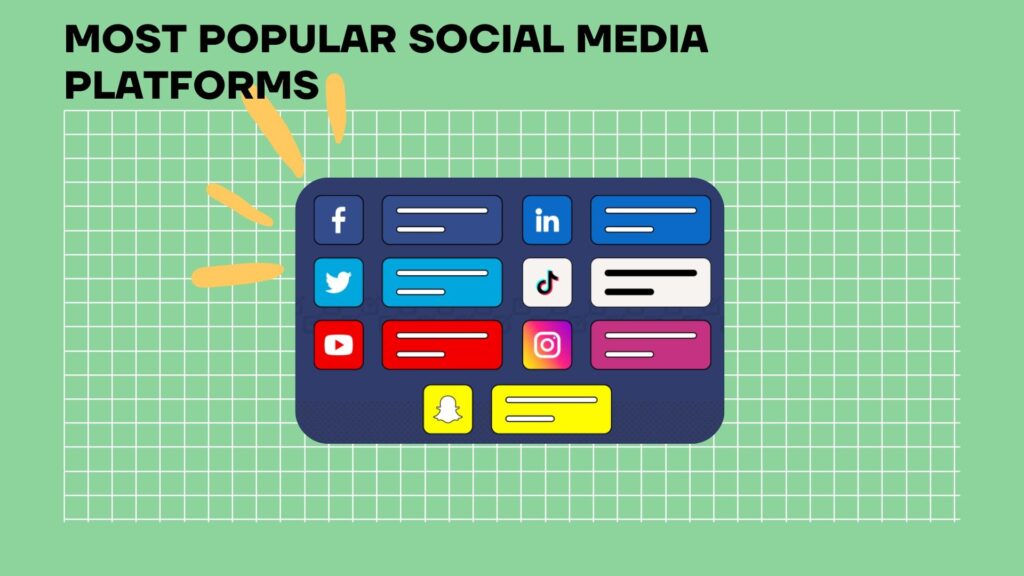
Social media platforms let you connect in real-time. Whether it’s Instagram, LinkedIn, or Facebook, focus on bite-sized content that grabs attention.
- Content ideas: Share quick tips, personal stories, client success snippets, and interactive Q&As.
- Time-saver: Use Buffer to batch schedule posts.
3.3. Email newsletters

With a high ROI of $36 for every $1 spent on email, newsletters are one of the best investments for relationship-building. They’re your one-stop content source—use them to create a steady flow of posts that keep your prospective clients engaged and tuned in. By repurposing a single piece of quality writing, you multiply its impact across multiple platforms without reinventing the wheel.
- Content: Monthly insights, upcoming events, and tips.
- Tool to try: Mailchimp lets you track open rates, clicks, and engagement.
3.4. Video content

Video lets people connect with you face-to-face. You don’t need high production—just authenticity. Use YouTube, TikTok, Instagram Reels, or StreamYard to share engaging, valuable videos to build rapport and demonstrate your expertise.
- Content ideas: Short clips of coaching techniques, live client Q&A, or myth-busting common challenges.
3.5. Podcasts
With podcasts, you can tackle in-depth topics, interview industry experts, or share actionable advice directly with your audience.
Content ideas
- Interviews: Invite thought leaders or past clients to discuss challenges and solutions.
- Actionable tips: Offer bite-sized coaching advice listeners can implement immediately.
- Behind the scenes: Share your journey as a coach or the process behind your methods.
Platforms like Anchor or Buzzsprout make podcasting easy and accessible. Set a goal, like producing one episode weekly, and track downloads or listener engagement to measure success.
4. Repurpose content
By repurposing, you breathe new life into your content, making it accessible to a broader audience while maintaining consistency.
How to repurpose effectively
- Turn blogs into infographics: Summarize key points into visual formats for social media.
- Video content into clips: Edit long videos into short, shareable segments for Instagram Reels or TikTok.
- Podcasts into blog posts: Transcribe episodes into detailed blog content for SEO and audience convenience.
- Social posts into email content: Use engaging social snippets as part of your email newsletters.
5. Create a content calendar
A content calendar prevents last-minute scrambles and ensures all your platforms work cohesively. It also helps balance your content mix, from evergreen topics to timely posts.
Steps to build a content calendar
- Plan ahead: Map out 3-6 months of content based on your goals and audience interests.
- Include formats: Alternate blog posts, social media updates, videos, and podcasts.
- Set deadlines: Assign publishing dates and track progress to stay accountable.
Pro tip: Semrush offers a downloadable, easy-to-use content calendar on Google Sheets. Fully customizable, it allows you to adapt the calendar to your specific needs, helping you organize and streamline your content plan effortlessly.
Leveraging Testimonials and Case Studies to Build Credibility

If there’s one thing that turns curious prospects into dedicated clients, it’s social proof. Testimonials and case studies aren’t just “nice to have”—they’re essential tools that showcase your expertise, credibility and build trust.
Gathering client testimonials: Timing, questions, and tactics
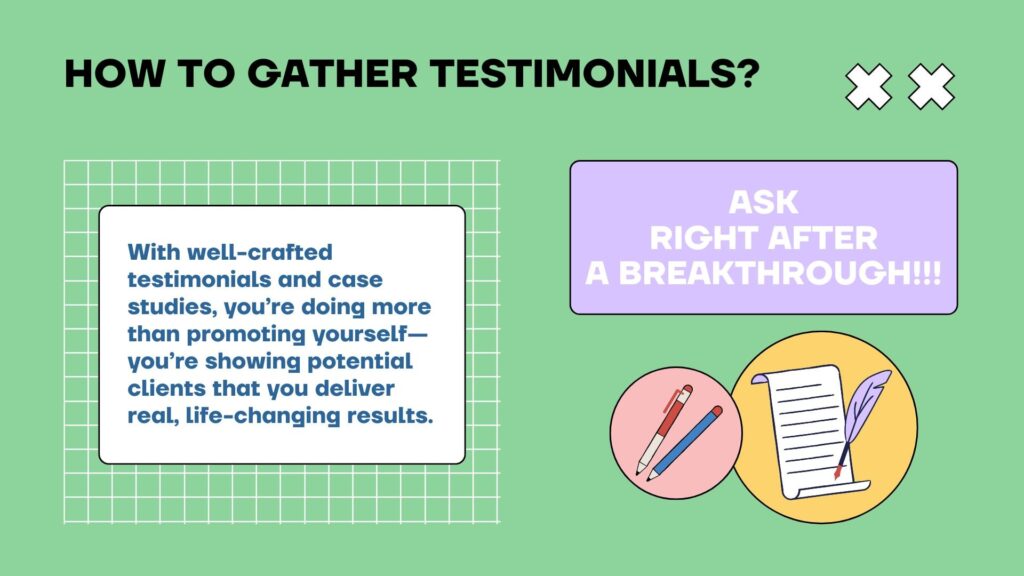
Getting testimonials isn’t just about asking for feedback; it’s about asking at the right moment and in the right way. Here’s how to get testimonials that tell a compelling story.
1. Ask right after a breakthrough
Timing is everything. Clients are at their most enthusiastic when they’ve just experienced a breakthrough, achieved a goal, or solved a problem with your help. This is the ideal time to ask for a testimonial—capture the emotion and excitement they’re feeling.
Avoid generic questions like “How was your experience?” Instead, get specific with prompts like:
- “How has coaching with me changed your life?”
- “What specific improvements have you noticed since we started working together?”
- “What was the biggest challenge I helped you overcome?”
2. Ask for permission to share across multiple platforms
Make the most of every testimonial by securing permission to share it across your website, social media, emails, and even in proposal materials.
Creative ways to share success stories

Once you’ve gathered great testimonials, it’s time to showcase them in ways that captivate and convert. Consider these approaches:
- Website highlights: Dedicate a section of your website to client success stories where potential clients can see a collection of positive experiences.
- Social media spotlights: Share short, punchy testimonials on platforms like Instagram or LinkedIn. If possible, post video testimonials—a client sharing their story face-to-face is one of the most powerful endorsements you can get.
- Newsletters and case studies: Turn longer testimonials into mini case studies that break down a client’s journey, the challenges they faced, and how you helped them succeed.
Do’s and Don’ts for authentic, impactful testimonials!

- DO focus on personal transformation and relatable stories. Testimonials should highlight the real-life changes clients have experienced through your coaching. For example, “With her guidance, I learned to set boundaries and regained control of my time” feels genuine and connects emotionally with potential clients.
- DO keep it concise. Testimonials don’t need to be long to be impactful. A few well-chosen sentences that capture the client’s experience and success are enough to make an impression.
- DO use real names (with permission). Authenticity matters. Using the full name or initials of your client builds trust and credibility.
- DON’T script testimonials. Authenticity shines through when clients share their experiences in their own words. Avoid giving them a script to follow.
- DON’T forget diversity. Showcase testimonials from clients with varied backgrounds and goals to resonate with a broader audience.
Measuring Success: Tracking Your Content Marketing ROI
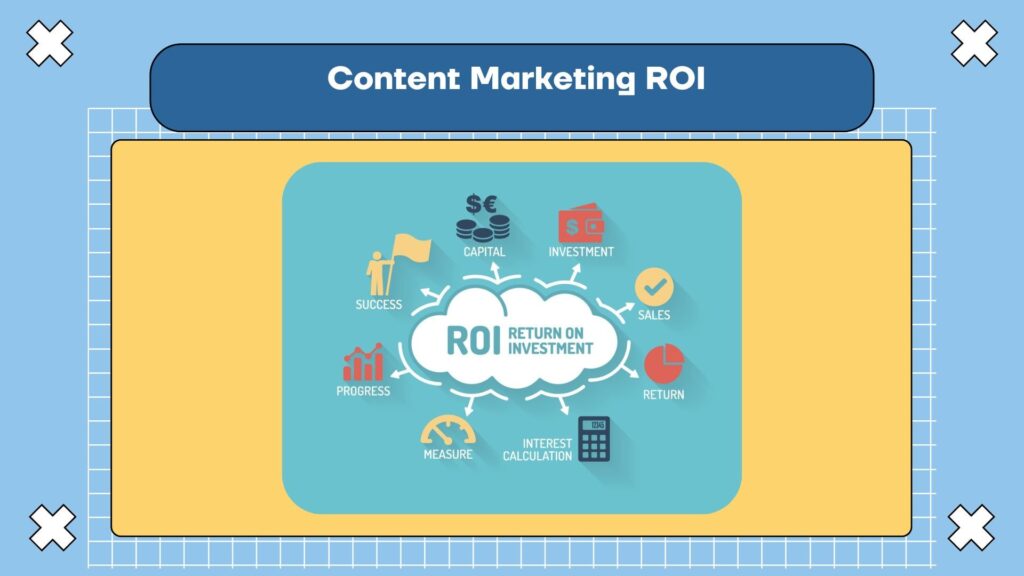
Content marketing without measurement is like coaching without goals. Here’s how to track and assess the effectiveness of your strategy.
Which metrics to track
- Website traffic: Monitor traffic trends to understand which content drives the most visitors to your site.
- Conversions and leads: Track form submissions, consultation bookings, or sales to measure how well your content converts readers into clients.
- User behavior metrics: Keep an eye on bounce rate and dwell time. A high bounce rate or low dwell time could indicate that your content isn’t engaging or relevant. Use these insights to refine your approach.
- Social engagement: Measure likes, shares, comments, and clicks to gauge how your audience is interacting with your posts.
- Email open rates and CTRs: Assess how effectively your email campaigns are capturing attention and encouraging clicks.
Setting KPIs aligned with content goals
If your goal is lead generation, a good approach would be to track conversions like calls booked, email signups, and new subscribers. For brand awareness, focus on metrics like new traffic and visitors acquired. These indicators reflect your success in reaching fresh audiences and expanding your visibility.
Quick metrics checklist for coaches
- Weekly: Track social engagement and email opens.
- Monthly: Review website traffic and conversion rates.
- Quarterly: Assess overall audience growth and content performance.
SEO for Coaches: Simple Steps for Big Visibility

Search Engine Optimization (SEO) doesn’t have to be intimidating. In fact, for coaches, SEO is about one thing: making sure clients can find you when they need you most. Done right, SEO can turn your website into a magnet for the clients you want to reach.
The Basics of SEO: Turning Searchers into Clients

1. Keyword research
Keywords are your gateway to connecting with potential clients. They reflect what people type into search engines when looking for services like yours. Tools like Semrush and Ahrefs are the best tools for this, offering insights into search volume, competition, and trends.
Targeting keywords by funnel stage
- Top of Funnel (TOFU): These are awareness-stage keywords, often long-tail and educational. Examples include “how to change careers midlife” or “tips for career transition.” These searches signal curiosity but no immediate intent to buy, making them ideal for blog posts and free resources that establish your expertise.
- Bottom of Funnel (BOFU): These keywords target searchers ready to take action. Phrases like “career coach for executives in Dallas” or “one-on-one career coaching services” indicate readiness to invest in your services. BOFU keywords work best on landing pages, service pages, and paid ads.
Pro tip: When building your keyword strategy, balance TOFU keywords to drive brand awareness with BOFU keywords to capture leads and sales. MyConentPal’s keyword research team can help pinpoint the terms your audience searches for at every stage of their journey.
2. On-page optimization
On-page optimization forms the backbone of SEO, helping your content stand out to both search engines and readers. Strategically place your target keywords in titles, headers, and naturally throughout the content. However, focus on readability—Google favors user-friendly, engaging content over keyword stuffing.
2.1. Enhance engagement with rich media!
Incorporate images, videos, or infographics to make your pages more engaging. Rich media doesn’t just improve user experience—it can increase metrics like dwell time (how long someone stays on your page) and reduce bounce rates.
Example: A blog post titled “5 Steps to Boost Self-Confidence” could include a short video demonstrating daily exercises, or an infographic summarizing key points.
2.2. Enhance readability!

SEO isn’t just about keywords; it’s about keeping readers engaged. Break up your text with short paragraphs, bullet points, and clear headings to make it easy on the eyes and accessible to skimmers.
Pro tip: Use tools like Hemmingway to check readability, making sure your content is simple yet engaging.
SEO best practices 101: Putting value first
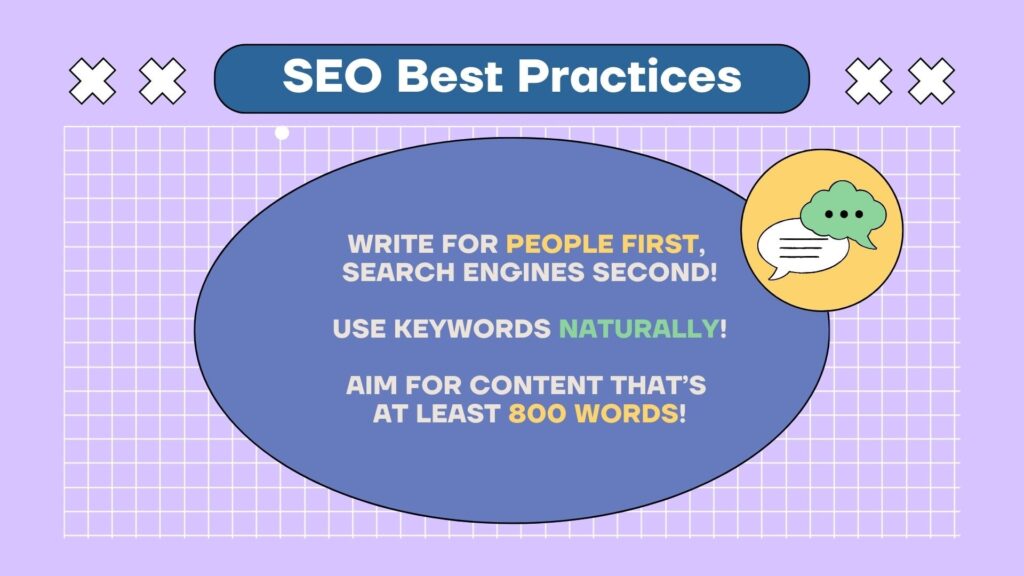
SEO is about balancing visibility with value. Here’s how to ensure you’re connecting with clients meaningfully:
- Write for people first, search engines second: Aim to solve client problems and answer their questions authentically. Google’s algorithms increasingly prioritize quality and helpfulness, so focus on delivering value with every post.
- Add multimedia: Images, videos, and infographics improve user experience by encouraging visitors to stay longer, reducing bounce rates, and increasing average session time—metrics that indirectly influence SEO rankings. For example, embedding a short introductory video or including an infographic on “5 Daily Habits for a Positive Mindset” makes your content more dynamic and accessible to visual learners.
Ready to Connect with Your Dream Clients Through Content?
Your coaching content has the power to inspire, engage, and convert—when it’s done right. Crafting a content strategy that speaks to your audience’s needs takes time and expertise, but here’s the good news: you don’t have to do it alone.
Let My Content Pal handle the heavy lifting. From strategy to SEO, our team of Writers, and Editors will ensure your message hits the mark while you focus on what you do best—coaching.
Book a strategy call with me, Craig Dewart, and let’s start building content that works for you!
FAQs
How to market your coaching program?
Start by defining your target audience, setting clear goals, and using a mix of content types (blog posts, social media, email) to reach and engage them.
How to create a program as a coach?
Identify the specific pain points and goals of your clients, then structure your program around actionable steps and outcomes that align with these needs.
Is the online coaching industry growing?
Yes, the online coaching industry is rapidly growing as more people seek accessible, specialized guidance for personal and professional growth.
Wrapping Up
Imagine focusing entirely on transforming lives while a dedicated team ensures your message reaches the right audience at the right time. That’s the magic of partnering with My Content Pal.
With our expertise, you’ll create content that reflects your unique coaching style, engages your ideal clients, and drives real results. Let us handle the strategy, SEO, and storytelling so you can do what you do best—empower others. Together, we’ll turn your content into a catalyst for growth and success.



